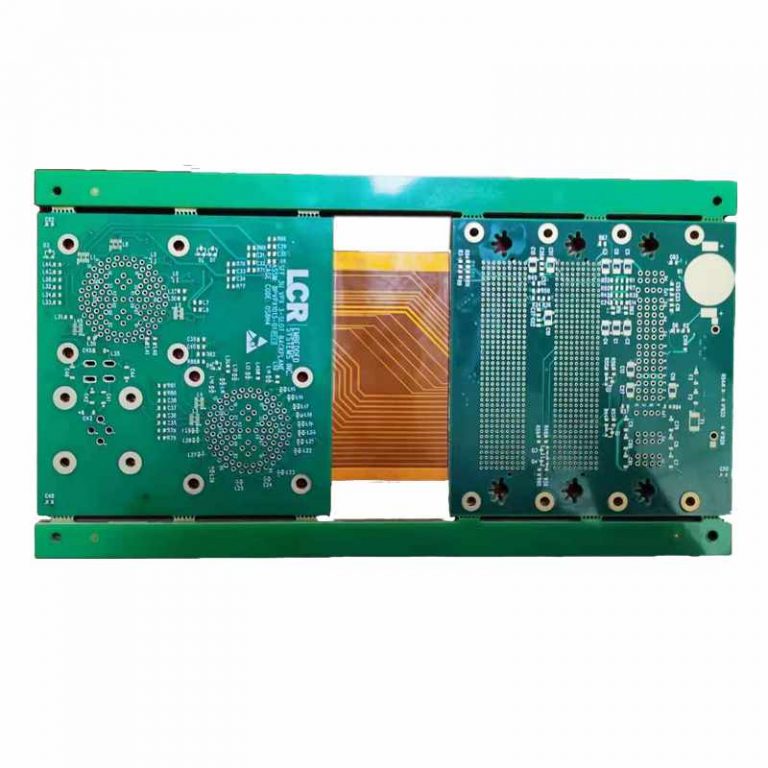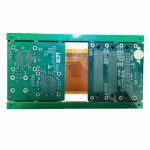Rigid-Flex PCB Advantages
Rigid-Flex PCB provides a simple means to integrate multiple PCB assemblies and other elements such as display, input or storage devices without wires, cables or connectors, replacing them with thin, light composites that integrate wiring in ultra-thin, flexible ribbons between sections. In rigid-flex packaging, a flexible circuit substrate provides a backbone of wiring with rigid multilayer circuit sections built up as modules where needed.
Rigid-Flex PCB applications also provide increased reliability. Mean time between failure rates (MTBF) typically exceed those of standard PCB sets with discrete wires and connectors, often becoming the choice of companies and engineers alike for its dependable and consistent performance.
RunTek PCBs factory has extensive experience, product knowledge and technical competency in this area. Our products can be found in the satellites, multiple military aircraft types and missile platforms. Joint development work is also done routinely with NASA and related agencies, as well as many others in the space and aerospace community. RunTek’s Flex & Rigid-Flex expertise can also be found in various medical and health related test equipment, computing networks, and various scientific and industrial applications.
Rigid-Flex PCB product types include:
- Type 1: Single sided flexible material with or without shield(s) or stiffener (one conductive layer).
- Type 2: Double sided flexible material with or without shield(s) or stiffener (two conductor layers) with plated through holes.
- Type 3: Multilayer flexible material with or without shield(s) or stiffener (more than two conductor layers) with plated through holes and HDI.
- Type 4: Multilayer rigid and flexible material combinations (more than two conductor layers) with plated through holes and HDI.
Service Offerings:
- Innovative Rigid-Flex Processes
- Premium Material Sets
- Rigid-Flex with HDI
- Loose Leaf Construction
- Oversized Panels
- Layer counts to 40+
- Heat Sink Application
- Internal Quality Standards that often exceed the requirements of IPC-6013, MIL-PRF-31032 and MIL-P-50884 for registration, hole quality and overall reliability.
Value-Added Solutions:
- Flex Assembly
- Product Engineering
- Design / Layout
- Reverse Engineering
- Technical Training
- VMI
- Concurrent Engineering
- Applications Support
RunTek ELECTRONICS – Your Leading Rigid-Flex PCB Supplier
Rigid-flex PCBs are boards that combine the best of flexible and rigid-board technology
Designs vary greatly, and can be combined with a wide range of materials to support multiple use cases in a constant state of flex — often a flexed curve created during the manufacturing process, or can be made during final installation.
Why You Need Rigid Flexible Circuits From RunTek PCBs Factory
These printed circuit boards create a more challenging design for rigid-flex manufacturers, but we’ve been able to supply successful designs with full compliance and reliability. By engineering these in a 3D environment, we’re able to achieve spatial efficiency and incorporate folds and flexes that can help you meet a desired shape that works best with your application.
A rigid-flex printed circuit board can help you with issues in reducing space, as well as making sure your products can stand up to tough conditions and ensuring they are cost-efficient. Using a rigid flexible format allows you to use fewer parts and interconnections and to take on more aggressive design challenges, as the rigid-flex PCB is a flexible solution to numerous design issues. They have applications for industries ranging from hearing aids to night vision goggles and more.
What Is the Difference Between a Flex and a Rigid-Flex Printed Circuit Board?
The rigid-flex printed circuit board gives you the best of both worlds. A rigid-flex PCB combines the flexibility of flex circuits with the durability of a rigid PCB. A flex-printed circuit board has only flexible materials, usually polyimide or polyester-based. They can be single-layer, double-layer or multilayer boards. A rigid flex PCB has both flexible and rigid materials, with flexible layers sandwiched in between rigid layers with conductors and plated through holes that connect them to the other layers.
Flexible circuit boards by themselves may not stand up to the wear of certain challenging applications, but standard rigid boards tend to be heavy and take up a lot of space. Combining rigid boards with flexible circuits reduces weight and space, giving you a streamlined product you can use in a wide variety of industrial situations.
Layout Recommendations for Rigid-Flex PCBs
Rigid-flex PCB suppliers like RunTek ELECTRONICS provide guidance on layouts and bends to keep your equipment safe. We wanted to present a quick overview to help you understand the thickness and other requirements you may need for your design.
| Circuit Construction | Bend Radius Calculation |
| 1 Layer (single-sided) | Flex Thickness x 6 |
| 2 Layer (double-sided) | Flex Thickness x 12 |
| Multi-Layer | Flex Thickness x 24 |

